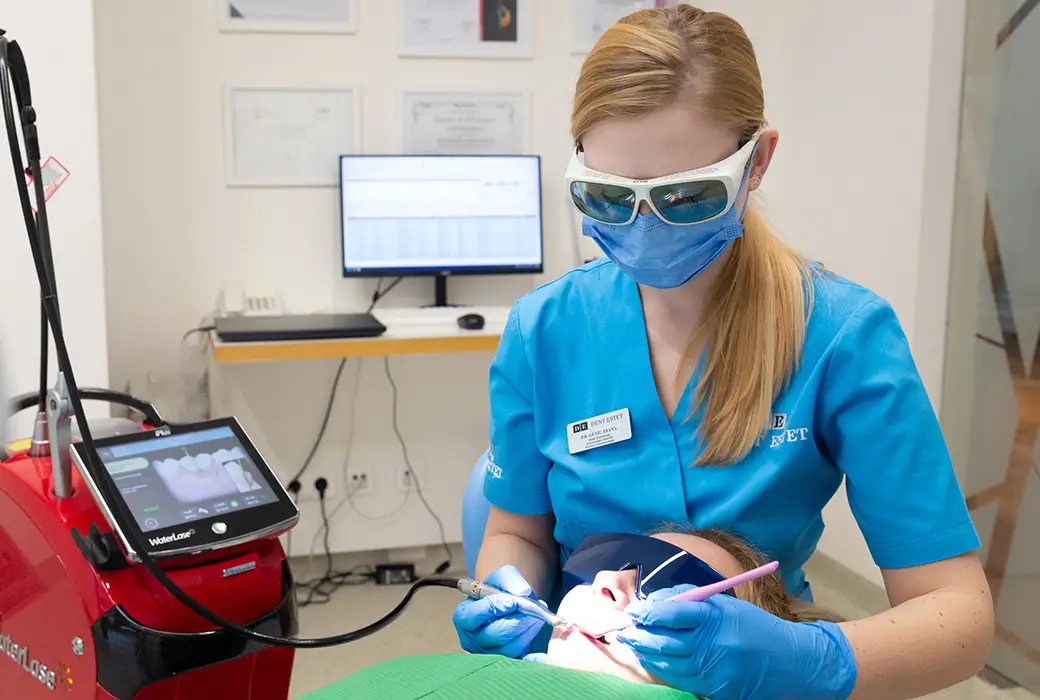
Gingivitis
Causes, symptoms, treatment, and prevention
Your teeth can reveal a lot about your overall health, and so can your gums. Are they pink and firm? Perfect! It means they are healthy. Do you feel sensitivity, inflammation, and are they red? You might have a gum condition.
Why does gum health matter? Healthy gums are pink and clean, provide firm and effective support for your teeth, do not bleed, and do not become inflamed.
What is gingivitis?
Gingivitis is a superficial inflammation of the gums. It occurs due to bacteria and represents the first stage of periodontal disease. Unlike the next stage, periodontitis, it is reversible. If not treated in time, it can progress to more serious conditions and even lead to tooth loss.
Regarding periodontal disease, it is the most common chronic inflammatory condition:
- 8 out of 10 people over the age of 35 have some form of gum disease;
- it ranks 6th among the most widespread diseases;
- it can lead to tooth loss and affect the entire body;
- it does not typically cause pain or intense discomfort, and the most common symptom is gum bleeding.
Why does gingivitis occur – main causes and risk factors
One of the most common causes of gingivitis is poor oral hygiene. This promotes excessive plaque buildup and inflammation of the gums. Plaque is made up of bacteria that accumulate on the surface of the teeth when food particles and sugars come into contact with bacteria normally found in the oral cavity.

As plaque builds up and is not removed in time, it starts to harden. Plaque needs to be removed daily through brushing. Otherwise, it turns into tartar. In turn, tartar begins to accumulate bacteria and irritate the gums, and it can only be removed through professional cleaning at a dental clinic.
The longer tartar remains on the tooth surface, the more it will irritate the gums, causing them to become inflamed. Over time, the gums become red and may bleed. If not treated promptly, gingivitis can lead to cavities, periodontal disease, and even tooth loss.

Risk factors
Gingivitis can occur in anyone who does not follow proper dental hygiene rules, but there are also other risk factors involved in the development of this condition, such as:
- Smoking or chewing tobacco;
- Advanced age;
- A diet low in vitamin C;
- Dry mouth syndrome;
- Dental procedures that hinder proper tooth cleaning;
- Hormonal changes, such as those during pregnancy or menstruation;
- Genetic factors;
- Certain medications;
- Certain diseases that weaken the immune system (HIV, leukemia).
Possible complications
As mentioned above, untreated gingivitis can lead to periodontitis and, in some cases, even tooth loss. Chronic gum inflammation has also been linked to respiratory diseases, diabetes, rheumatoid arthritis, or coronary artery disease. Some studies suggest that bacteria causing periodontitis may enter the bloodstream through the gum tissue, potentially leading to other more serious health issues.
Pregnancy gingivitis occurs due to hormonal changes that alter the body's response to bacterial plaque aggression, resulting in gum inflammation and bleeding. Studies have shown a direct relationship between gum disease and pregnancy complications such as preeclampsia, preterm birth, or giving birth to an underdeveloped baby.
Acute necrotizing gingivitis is a severe form of gingivitis that causes pain, infections, bleeding, and even mouth ulcers. However, these cases are not common and occur only in exceptional situations.
What are the symptoms of gingivitis?
The main sign of gingivitis is bleeding gums, which does not occur in smokers. Other signs that indicate the onset of gingivitis include:
- Swollen gums;
- Gums that have a dark red hue;
- Bleeding gums during brushing;
- Bad breath;
- Gum recession;
- Sensitive gums.
If you notice these symptoms, it is recommended to visit a dentist. The sooner you treat gingivitis, the less likely it is to progress and cause further complications.
It is important to remember that healthy gums are firm, have a pale pink color, and are tightly attached to the teeth. Any change can be a sign of a problem.
How is gingivitis diagnosed?
To diagnose gingivitis, a visit to the dentist is necessary. The diagnosis will be based on the following investigations:
- Medical history;
- Examination of the teeth, gums, and tongue to check for plaque, inflammation, or gum recession;
- Digital X-ray to assess the condition of the tooth roots.
If needed, the dentist may recommend additional tests to identify other health issues that could contribute to gingivitis. If gingivitis is in an advanced stage, a specialist in gum problems may need to be consulted.
How is gingivitis treated?
Treatment for gingivitis should be carried out as early as possible to prevent complications. Professional treatment of gingivitis generally includes the following procedures:
- Professional teeth cleaning – such as removing plaque, tartar, and bacteria from the oral cavity.
- Dental restoration – if there are fillings or crowns that hinder proper cleaning of the teeth or cause gum irritation, the dentist will address the affected teeth.
Additionally, the dentist will recommend a home dental care routine. Daily oral care is essential for treating gingivitis, and if you strictly follow the care routine, your gums will gradually return to a pink color, and the tissues will heal within a few days or weeks, depending on the case.
How to prevent gingivitis
The occurrence of gingivitis can be prevented by following a few essential rules:
- Proper oral hygiene – You should brush your teeth at least twice a day, in the morning and evening, and use dental floss at least once a day. Additionally, it is recommended to brush your teeth after each meal. Use dental floss before brushing to better remove food particles that can contribute to bacterial buildup.
- Regular dental check-ups – It is essential to visit the dentist regularly, every six months to a year. If there are risk factors that increase the likelihood of periodontal disease, professional scaling and cleaning are even more important. Additionally, dental X-rays can detect any potential dental issues early on.
- Balanced diet – Diet significantly impacts oral health, and for individuals with diabetes, it is crucial to control blood sugar levels as it affects gum health. Recommended foods include greens, citrus fruits, green tea, apples, celery, and dairy products.
Healthy gums not only contribute to a beautiful and natural smile but also help:
- prevent tooth mobility or loss;
- prevent and control systemic diseases;
- prevent aesthetic dental problems;
- prevent speech issues;
- prevent bad breath or chewing problems;
- prevent irreversible issues with teeth and gums;
Myths about periodontal disease
Gum disease is not common:
- on the contrary, more than half of adults over the age of 30 suffer from some form of periodontal disease (disease of the structures supporting the teeth).
I don’t have cavities, so I can’t have periodontal disease:
- the absence of cavities does not ensure the absence of periodontal disease, as this condition can progress without pain or obvious symptoms (the disease of seemingly healthy teeth).
If I have gum disease, I will lose my teeth:
- it is not inevitable to lose your teeth if you have gum disease. With proper brushing, using additional hygiene measures, and regular check-ups with a dentist, you can halt the progression of the disease.
Bleeding gums during pregnancy is normal:
- while it is true that some women develop pregnancy gingivitis, it does not mean that everyone will experience this. You can prevent it by paying extra attention to oral hygiene to remove bacterial plaque.
Bad breath is an indicator of gum disease:
- persistent bad breath or an unpleasant taste in the mouth can be an important indicator in diagnosing gum disease as well as other general health issues.
I have diabetes. Will I develop periodontal disease?
- if you have diabetes, there is a higher risk of developing dental problems, so you need to pay more attention to oral hygiene.
In other words, proper dental hygiene and regular visits to the dentist can prevent the occurrence of gingivitis and its complications.


